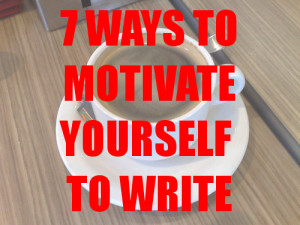
Photo by Anthony PC
It hardly ever fails. Just when you sit down to write, no matter how long you’ve been waiting for the chance, you suddenly feel like doing anything else.
Check Facebook. Watch Netflix. Clean toilet.
Part of it is being tired. I know. Most of us are writing in the wee spare hours between the full-time job, school, cooking, cleaning, child-rearing and whatnot.
But if you wait to feel like writing, you never will. If you wait for inspiration to find you, it never will. You have to make it happen.
Here are some ways to do that.
1. Publicly commit to a deadline
There’s nothing like accountability. If I wasn’t committed to posting on this blog every Monday and Friday, you’d probably never hear from me. Make your own commitment by meeting regularly with a writer’s group or a critique partner, or try signing up for NaNoWriMo or the 3-Day Novel contest (please note I recommend spending considerable time after these writing marathons editing your work).
2. Keep a favorite book close
Is there a particular book that always gives you the urge to put pen to paper? Keep it close to your writing space and read a few pages when you sit down to write. I find great motivation in Marcus Zusak’s The Book Thief and Ray Bradbury’s Zen in the Art of Writing.
3. Train your brain
Develop a routine: Choose the same time to write every day (when your mind is freshest, if possible). Listen to the same type of music, drink the same type of tea, light the same scented candle – or all three. In time, the sensory repetition will help to trigger that writing urge in you.
4. Escape from the Internet
Web 2.0 has turned the Information Age into the Distraction Age. Remove yourself completely from the temptation to surf by taking your laptop to a place without Wi-Fi, or just use a notebook or old school typewriter (don’t you love the sound anyway?).
5. Take the hint
If you can’t get the motivation to write because you’re just bored with it, chances are your readers will be bored with it, too. Find a more interesting way to tell the story. Revisit your plot to find opportunities to increase drama and decrease exposition.
6. Get your 8 hours and drink a cup
I’ve heard some people don’t need a full 8 hours of sleep per night, but personally, I function much better after 8 hours of sleep vs. even 7. And when you’ve had a full night’s rest, caffeine doesn’t just resuscitate your zombie self – it makes you want to write and create and be generally brilliant at turbo speed. NOTE: I decrease my coffee consumption throughout the week (e.g. one cup Monday, down to a quarter cup on Friday, another full cup the following Monday) so I don’t have to keep upping the dose to get the same “buzz.” This method also prevents caffeine headaches if you go a day without it.
7. Visualize the finished piece
I know this sounds rather hippie-zen, but it’s actually pretty powerful. Do you want to be just working on this book forever? Or do you want to hold the hardcover edition in your hands with your own name staring back at you in glorious black and white?
—
Thanks to Spider42 for suggesting this topic. Want a topic you want talked about? Drop it in the Suggestion Box!

7 Ways to Motivate Yourself to Write





